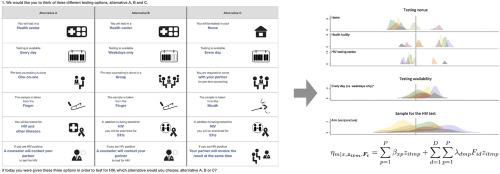Journal of Choice Modelling ( IF 4.164 ) Pub Date : 2021-07-11 , DOI: 10.1016/j.jocm.2021.100305 Jan Ostermann 1, 2, 3, 4 , Brian P Flaherty 4, 5 , Derek S Brown 4, 6 , Bernard Njau 7 , Amy M Hobbie 3, 4 , Tara B Mtuy 7, 8 , Max Masnick 9 , Axel C Mühlbacher 4, 10, 11 , Nathan M Thielman 3, 4

|
Efforts to eliminate the HIV epidemic will require increased HIV testing rates among high-risk populations. To inform the design of HIV testing interventions, a discrete choice experiment (DCE) with six policy-relevant attributes of HIV testing options elicited the testing preferences of 300 female barworkers and 440 male Kilimanjaro mountain porters in northern Tanzania. Surveys were administered between September 2017 and July 2018. Participants were asked to complete 12 choice tasks, each involving first- and second-best choices from 3 testing options. DCE responses were analyzed using a random effects latent class logit (RELCL) model, in which the latent classes summarize common participant preference profiles, and the random effects capture additional individual-level preference heterogeneity with respect to three attribute domains: (a) privacy and confidentiality (testing venue, pre-test counseling, partner notification); (b) invasiveness and perceived accuracy (method for obtaining the sample for the HIV test); and (c) accessibility and value (testing availability, additional services provided). The Bayesian Information Criterion indicated the best model fit for a model with 8 preference classes, with class sizes ranging from 6% to 19% of participants. Substantial preference heterogeneity was observed, both between and within latent classes, with 12 of 16 attribute levels having positive and negative coefficients across classes, and all three random effects contributing significantly to participants’ choices. The findings may help identify combinations of testing options that match the distribution of HIV testing preferences among high-risk populations; the methods may be used to systematically design heterogeneity-focused interventions using stated preference methods.
中文翻译:

哪些因素会影响 HIV 检测?使用潜在类别和与类别无关的随机效应对偏好异质性进行建模
消除艾滋病毒流行的努力将需要提高高危人群的艾滋病毒检测率。为了告知 HIV 检测干预措施的设计,一项离散选择实验 (DCE) 具有六种与政策相关的 HIV 检测选项属性,在坦桑尼亚北部引发了 300 名女性酒吧工作人员和 440 名男性乞力马扎罗山搬运工的检测偏好。调查于 2017 年 9 月至 2018 年 7 月期间进行。参与者被要求完成 12 项选择任务,每项任务都涉及 3 个测试选项中的第一和第二最佳选择。使用随机效应潜在类 logit (RELCL) 模型分析 DCE 响应,其中潜在类总结了常见的参与者偏好配置文件,随机效应捕获了关于三个属性域的额外个人水平偏好异质性:(a) 隐私和保密(考场、考前咨询、合作伙伴通知);(b) 侵入性和感知准确性(获取 HIV 检测样本的方法);(c) 可访问性和价值(测试可用性、提供的附加服务)。贝叶斯信息准则表明,最适合具有 8 个偏好类别的模型,班级规模从 6% 到 19% 的参与者不等。在潜在类别之间和内部观察到了显着的偏好异质性,16 个属性级别中有 12 个在类别之间具有正系数和负系数,并且所有三个随机效应都对参与者的选择有显着贡献。这些发现可能有助于确定与高危人群中 HIV 检测偏好分布相匹配的检测选项组合;



























 京公网安备 11010802027423号
京公网安备 11010802027423号